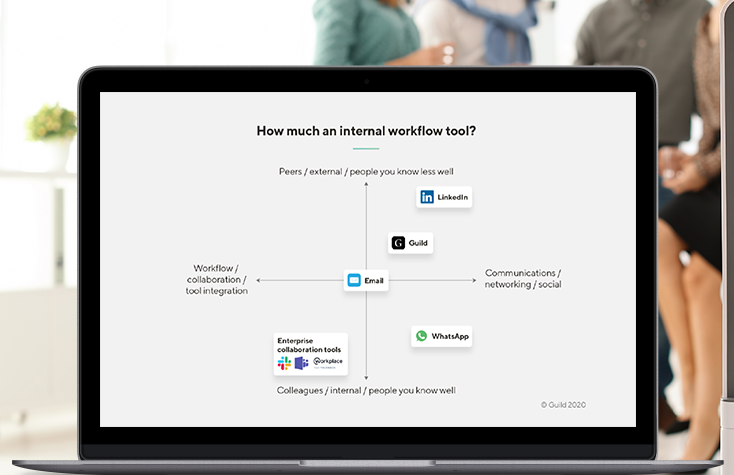What Increased Work-Related Messaging Means for Companies
The ongoing Covid-19 crisis has been a catalyst for many organisations to support remote working more comprehensively and remove potential barriers to effective communication. But what can companies do to promote the sharing of information internally while ensuring that employees are using messaging appropriately and productively?

Consumer research carried out by Kantar across 25,000 consumers and 30 markets has shown a 40% increase in the use of WhatsApp during lockdown, with people seeking to stay connected with family and friends at a time when they have not been able to see them.
It is not surprising that work-related messaging is also increasingly. According to professional messaging app Guild, there was a huge 120% increase in total messages sent on its platform for the three months after UK lockdown on 23 March 2020 compared to the three months prior to that date.
Digital communications consultant Sharon O'Dea commented: "Covid-19 has been a steep learning curve for all of us. The early weeks saw the ‘Zoom Boom’ as we sought to maintain our office relationships and ways of working. But as the weeks have ticked on people have realised there are easier ways to get work done.
“Working asynchronously using messaging is less demanding of time and attention and allows us to work more flexibly. So I’m not surprised to see workers adopt this in the later weeks of lockdown. As we shift into this ‘new normal’ we’re all finding what works for us and our colleagues. I see messaging being a key part of that mix for the long term.”
With people more eager than ever to communicate with colleagues and clients through messaging apps, we thought it worth recapping on some trends and best practices that organisations need to be aware of, drawing on Guild’s Messaging in the Workplace report, produced with help from Digital Doughnut sister company London Research earlier this year.
The blurring of professional and personal communications
‘Off-topic’ conversations between different individuals and teams within an organisation are positive for morale, productivity and serendipity. With those watercooler moments now curtailed for most businesses, conversations through software collaboration and messaging tools are helping to fill the void and maintain a level of community.
Organisations should be wary of policing their employees too much, as giving employees a degree of autonomy fosters a culture of innovation and team collaboration, while also enabling people to air their frustrations.
But at the same time companies should ensure their employees are communicating on the right type of platforms. The diagram below taken from the Guild report shows different types of technology being used for professional communication, including email, workplace collaboration tools such as Microsoft Teams, professional messaging apps such as Guild, and consumer messaging platforms such as WhatsApp.
While the ubiquity of WhatsApp makes it a highly convenient tool for people to use, organisations should also consider whether they are comfortable with the lack of corporate oversight and control when consumer messaging platforms are used for business communications.

Best practices for workplace messaging
The Messaging in the Workplace report explores what companies should be doing to make the most of real-time messaging communication. The key recommendations are summarised as follows:
- Audit how messaging is currently being used. Senior management may actively encourage or discourage messaging at work, but in terms of business strategy and corporate governance, organisations should audit and put some form of formal strategy and guidance in place.
- Develop a strategy for workplace or business messaging. Organisations need to consider different business areas and clearly set out goals and objectives. This will of course vary according to the organisation’s specific requirements and the business outcomes they are seeking to achieve.
- Develop a model to show what form of professional messaging to use. Companies should work on a model that addresses what, when, and why, different types of communications should be used, based on the purpose of the communication and the needs to be met.
- Create a messaging guidance framework for employees. This framework should clearly spell out the dos and don’ts for employees, communicating clearly why different tools are appropriate for different purposes, and reminding them of their responsibilities. Messaging should be aligned to existing processes and policies (most notably security and data compliance), and corporate governance.
- Develop mechanisms to monitor success, employee engagement and well-being. Organisations should measure what they are doing to ensure they are getting the right type of behaviour and results.
- Empower employees to feed back and shape the role of messaging in the organisation. Communication and efforts to bolster company morale will be successful only if people within the business feel empowered to inform and improve the process. Employees should feel that information is being shared with them, so they’re able to raise any questions or query policies.
Read Guild’s Messaging in the Workplace report to learn more about related trends and best practice.